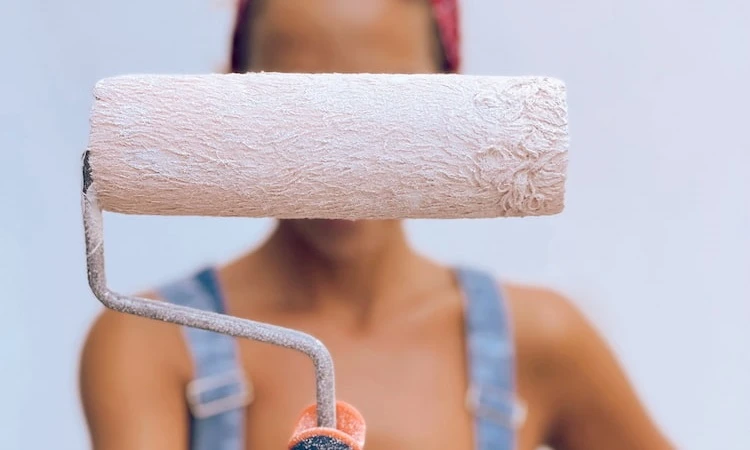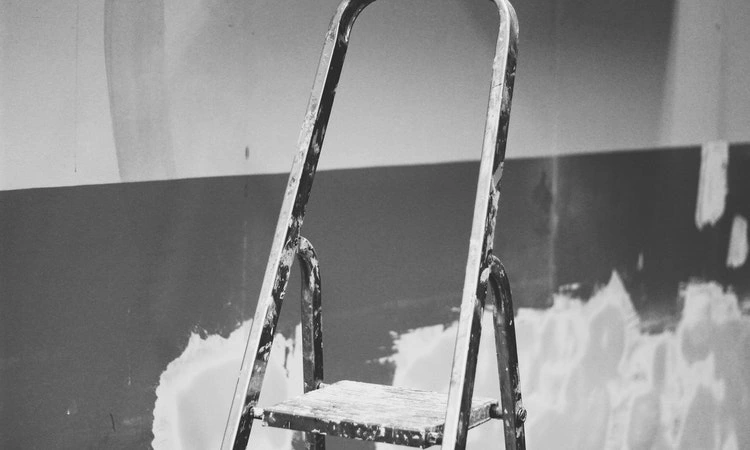Are you preparing to repaint either the interior or the exterior of your home? Then you may be wondering whether you should use interior or exterior paint.
More importantly, you need to know if there is a difference between the two kinds of paint.
Interior and exterior paints are created for different purposes.
Therefore, they have different formulas and properties. Before you start any painting project, you should know the differences between these two types of paint.
Interior paints are designed to be easily cleaned and resist staining. They are also designed to release fewer paint fumes.
Exterior paints are designed to withstand temperature swings, humidity, cracking, chipping, and more.
There are some significant differences between exterior and interior paints. In this article, I will help you understand these key differences.
I hope this information answers all of your questions and you can feel confident when choosing which paint you need for your home projects.
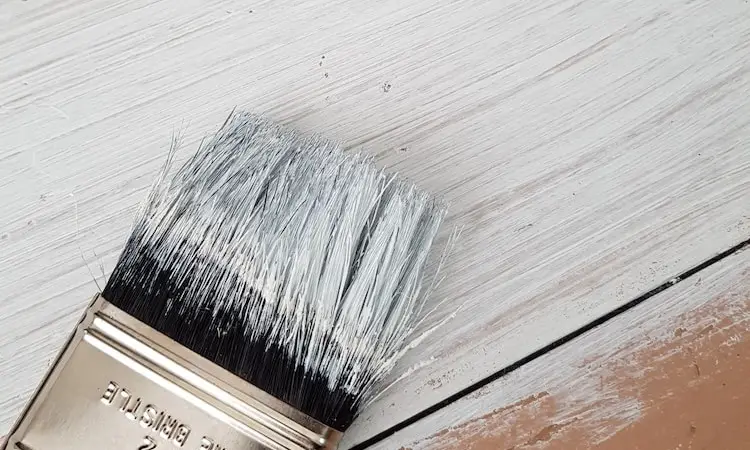
What is Interior Paint Used For?
Interior paint is used for aesthetic and decoration purposes. It does not have to withstand harsh outdoor elements.
However, it does need to withstand normal wear and tear. Therefore, it is designed to be able to resist staining and scuffing. It is also designed to be cleaned easily.
Things you can paint with interior paint:
- Interior walls
- Furniture (desks, bookcases, tables, dressers, etc.)
- Cabinets
- Interior doors
What is Exterior Paint Used For?
Exterior paint is used for any project exposed to the outdoor elements. It is designed to withstand wind, rain, hail, snow, and whatever else nature throws at it.
It also contains additives to stand up against cracking and chipping.
Things you can paint with exterior paint:
- Outdoor furniture (picnic tables, patio sets, etc.)
- The exterior of a house or building
- Outdoor decorations (i.e., wood signs)
- The exterior side of a door
- Fences
- Barns
The Basics of Paint
Before I can dive into the differences between exterior and interior paints, you need to know the basic components of paint.
This will help you better understand how these two types of paint differ. So what are the main components of paint?
- Pigment: Pigments are a powder used to create the color of the paint. They can be plant-based, animal-based, or synthetically formulated substances.
- Solvents: The solvent is what makes the paint “wet.” Solvents can be water-based or oil-based. They will evaporate as the paint dries. Different solvents will evaporate and dry at different times.
- Resin (binder): Resin binds the pigment in the paint to the surface you are painting.
- Additives: Additives are used to give the paint different properties. For example, some additives can make the paint resistant to mildew.
You can learn more about all components of paint in this article.
15 Differences Between Interior and Exterior Paints
Interior and exterior paints differ in more than just their purposes and where they can be used. Below I will go in-depth on a wide range of their differences.
Please remember that I am not saying one type is better than the other. I am simply providing you with information on how these paints differ.
Interior Versus Exterior Paint Comparison Table
| Interior Paint | Exterior Paint | |
|---|---|---|
| Type of Resin Used | Epoxy or silicone | Acrylic |
| VOC Level | Low to none | High |
| Fade Resistance | ✖ | Resists fading from UV rays |
| Type of Solvent Used | Water-based | Water-based or oil-based |
| Mildew Resistance | ✖ | ✔ |
| Outgassing | Minimum to none | ✔ |
| Water Resistance | Water resistant | Waterproof |
| Weather Resistance | ✖ | ✔ |
| Adhesion | Good | Best |
| Temperature Resistance | Low | High |
1. Type of Resin Used
The resin material in paint is an organic substance that allows the paint’s pigment to adhere to surfaces. Exterior paints require a flexible resin because the paint will be subjected to constant environmental changes.
A flexible resin allows the paint to grow and shrink with temperature changes. Since the paint can contract and grow as needed, paint is less likely to chip or peel.
Additionally, the resin used in exterior paints is softer than in interior paints.
On the other hand, interior paints are created with a more rigid resin. Interior paints are not subjected to constant temperature swings, so the paint does not need to be flexible.
The rigidity of the resin also makes the paint stand up better to scuffing.
How often do you accidentally push your chairs into your walls? The rigid resin in the paint prevents the wall from being easily scuffed.
It also allows you to clean the wall without the fear of damaging it. You can use a sponge or mop to clean your walls safely.
So what kind of resin is used in paint? Acrylic is often used as the binding resin in exterior colors.
The acrylic gives the paint a strong bond and increases its durability. Interior paints use epoxy or silicone resins because they do not smell as harsh as acrylic.
2. VOC Levels
Volatile organic compounds (VOCs) are toxic and can cause health problems when exposed to them for a prolonged period.
You should always paint in a well-ventilated area to decrease your risk of serious health concerns.
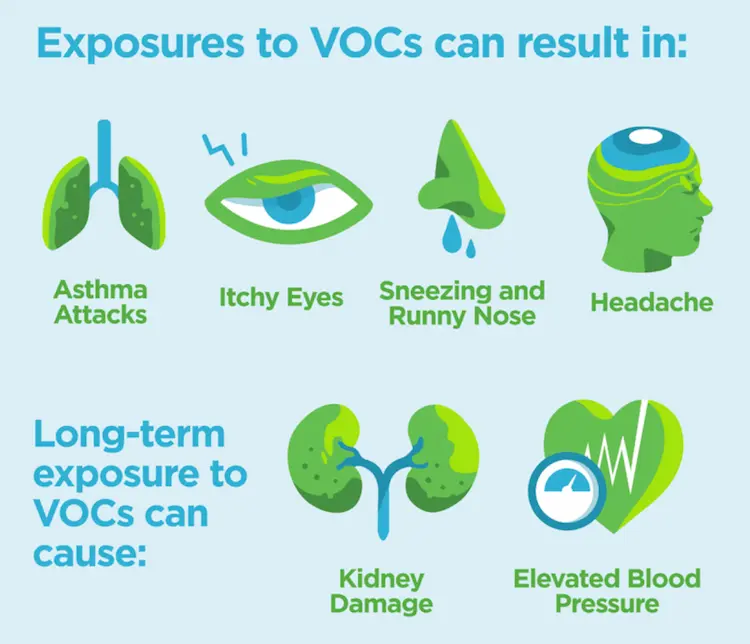
Exterior paints are designed to withstand temperature changes, mildew, and pest infestations. Because of that, they have more chemicals than interior paints.
More chemicals in the paint equal more VOCs the paint can emit into the air.
Interior paints do not need all the extra chemicals in exterior paints. The interior of your house will not be exposed to mildew and temperature changes compared to the exterior surfaces.
Manufacturers are aware of the health risks associated with exposure to high VOCs.
Because of that, interior paint is created with lower or zero VOCs. Even when painting with low or zero VOC paint, you should make sure the room is well-ventilated.
3. Fade Resistance
Sunlight hits your house for at least 12 hours a day throughout the majority of the year.
Could you imagine those constant UV rays on your skin and the effect they would have? Some people may notice their skin turns darker after UV exposure.
But the paint on a house can fade from consistent and constant exposure. Luckily, exterior paints have additives in them to protect them from fading caused by UV rays.
Interior paints are not exposed to the same amount of UV rays as exterior paints. Therefore, they are often not created with a fade-resistant formula.
Related Read: Can You Use Interior Paint Outside?
4. Type of Solvent Used
Water-based paints can be found in both interior and exterior paints. However, oil-based paints are often only used for exterior paints.
Why does this occur? Oil-based paints have a more powerful odor, and they can be more difficult to clean up.
Oil-based paints are also more common for outdoor paints because they are more resistant to dirt. You should remember that oil-based paints will dry slower than water-based paints.
It is also believed that there is little to no difference in the durability of water-based versus oil-based paints.
5. Mildew Resistance
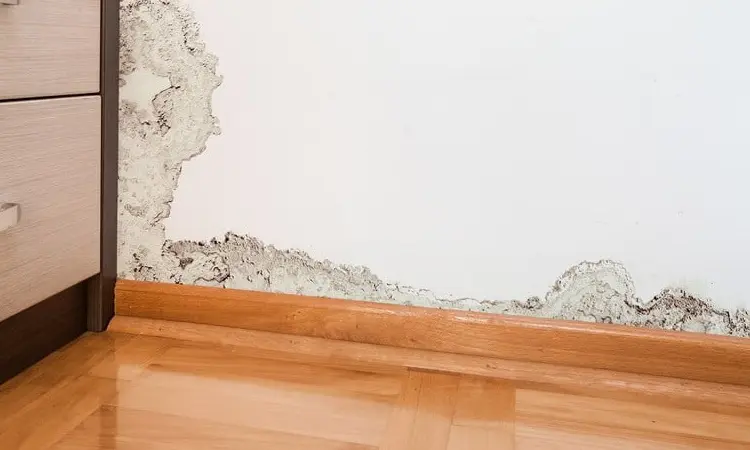
The surfaces inside a house are less likely to be exposed to algae, mildew, or mold. But the outside of your house is exposed to these regularly.
Mildewcides are often mixed into exterior paints to combat this issue.
6. Outgassing
Outgassing is the process of gas that was previously trapped being released. During hot and humid days, the paint on the exterior of a house expands more than normal.
This releases gasses that were previously trapped when the paint originally dried.
Exterior paints are often prone to outgassing due to all of the added chemicals in their resin. Typically, this only occurs for 48 hours.
But it can occur months or even years after application. As previously stated, the smell can become obvious on extremely humid or high-temperature days.
Interior paints do produce outgas, but it is not as strong. The paint will normally stop producing gases once it is dry.
This occurs because the paint is more rigid. Since this paint is not shrinking and expanding it is not allowing gases to escape.
7. Water Resistance
Did you know that interior paints are water-resistant while exterior paints are waterproof? In general, interior paints are not subjected to the same amount of water as exterior paints.
It may be annoying when your paint stains from a leak, but it is not meant to withstand that volume of water.
Interior paints were designed to withstand regular cleanings, not rainstorms or leaks. Many interior paints can only withstand up to 20 psi of water pressure.
At the same time, exterior paints need to be waterproof. This paint expands and contracts, so it needs to be able to repel water.
8. Type of Pigments Used
As previously mentioned, both exterior and interior paints have pigments in them. There are different types of pigments available.
Interior paints are generally created with organic pigments, and exterior paints usually use synthetic pigments.
Interior paints contain organic pigments for a couple of reasons. Organic pigments tend to be brighter in color. They are also considered safer and less harmful to breathe.
However, most organic pigments will fade quickly when exposed to UV rays.
Exterior paints need to be able to withstand UV exposure. That is where synthetic pigments come in. Synthetic pigments are used in exterior paints because they are less likely to fade when sunlight exposes.
These pigments do emit a more pungent and harsh odor.
9. Scratch Resistance
You may be surprised to learn that exterior paint is more prone to scratching.
Most people assume that because it stands up to the outdoor elements, it will be less likely to scratch. But quite the opposite is true.
Exterior paint is designed to be flexible. This, in turn, makes the paint softer.
You will often not notice that the exterior of your horse is scratched. On the contrary, you will notice if the paint on your interior walls becomes scratched.
You spend more time inside your house. Therefore, you will notice more imperfections. You are also more likely to scuff furniture on your walls.
Have you ever had wall decorations wall down? Or have your kids ever gotten into a fight, and one was thrown against the wall?
If you use high-quality interior paint, you will not see scratches or scuffs on the walls. The finish you choose will also determine if the imperfections are noticeable. This applies to interior and exterior paints.
10. Physical Damage Resistance
While exterior paint is more prone to scratches, it does hold up better to other physical damage.
When the paint is hit with twigs, rocks, etc., it will show signs of damage, but the paint will not chip away or begin to peel.
If your interior paint were to have a twig thrown at it, you would likely see the paint chip away, possibly exposing old paint. Exterior paints are exposed to more flying projectiles and are created to have the durability to resist damage.
Remember earlier when I talked about the different resin materials? The resin in exterior paint has a much stronger bond to surfaces than in interior paint. The paint can be chipped, but it will require a lot of force due to this strong bond.
11. Sheen Options
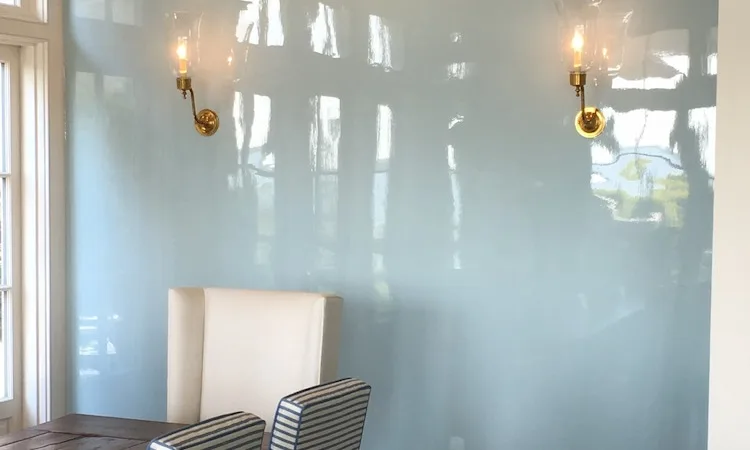
Typically sheen options for interior paints include matte, eggshell, pearl, gloss, and semi-gloss.
In comparison, exterior sheens include flat, semi-gloss, gloss, and high gloss. I have listed these sheens in order from least durable to most durable and shiniest finish.
These sheens can be used interchangeably between the types of paint. However, most brands use these to differentiate their interior and exterior options.
12. Drying Time
When you paint outside, the paint will dry faster than when you paint inside.
The paint is exposed to moving air and heat. Both of which cause the paint to dry faster. Hence, why exterior paint will dry faster than interior paint.
Remember, oil-based paints will dry slower than water-based paints. They will still dry faster outside than when painted inside.
This is something to keep in the back of your head when choosing between oil and water-based paints.
13. Weather Resistance
How often do the interior walls of your house get hit with hail, rainstorms, or hurricane winds? Probably not very often.
That is why interior paints do not have the same weather resistance as exterior paints.
Your interior walls do receive some UV rays, but it is significantly less than the exterior of the house. So it makes sense that the exterior of your home would have more protection against UV rays.
This also preserves the color of the paint as it will not fade quickly.
14. Adhesion
Either kind of paint possesses good adhesive properties. But think about all the bad weather the exterior of your house goes through.
Exterior paints must have a strong enough adhesion to stand against those harsh elements.
This strong adhesive capability also allows the exterior paint to last better and longer on exterior surfaces. On the other hand, interior paints do not need that strong of an adhesive bond.
Interior paints will still last for years when painted on interior surfaces.
Related Read: Can You Use Exterior Paint Inside?
15. Temperature Resistance
How many of you live in an area where the outside temperature stays consistent all year long? Not very many of you.
Thankfully, exterior paints are made to withstand those crazy temperature swings you get.
Most of you will keep the temperature in your house the same all year long. You may change it from heat to ac, but generally, it is the same temperature.
Even if you change the temperature, you do it in small increments so that you do not overload your system.
Therefore, interior paints do not need to be as durable against temperature swings.
FAQs: Interior Paint vs. Exterior Paint
After reading all of that information, you may have more questions than you started with. Hopefully, that is not the case. But below, I have answered a few other questions you may be asking about interior and exterior paints.
1. How Do Hybrid Paints Differ from Interior and Exterior Paints?
Hybrid paints can be painted on the interior and exterior surfaces.
Since they are a mix of the two paints, they lack a lot of additives that you normally find in exterior paints.
You will often notice them cracking and peeling faster than regular exterior paint.
They are known to be prone to mold and mildew problems.
Hybrid paints can be good for small projects, and they perform better outside than inside.
Overall, you will see better performance by choosing an interior or exterior paint, depending on your project.
2. Is it OK To Mix Interior and Exterior Paint?
Surprisingly, it is possible to mix interior and exterior paint. You will need to ensure the paints are the same color and type.
For example, you can not mix water-based paint with oil-based paint.
While it is possible to mix these two kinds of paints, I do not recommend you mix them. As I have previously mentioned, exterior paints have a higher amount of VOCs.
Mixing interior and exterior paints will not dilute the amount of VOCs present.
3. Is Exterior Paint Thicker Than Interior Paint?
Many assume exterior paints are thicker because they must withstand more environmental factors.
While the thought process makes sense, there is another reason exterior paints are thicker than interior paints.
Exterior paints are often oil-based paints.
Oil-based paints are thicker than water-based paints. If you have water-based exterior paint, it will generally be the same thickness as interior paint.
4. Is Exterior Paint More Durable Than Interior?
You have to keep in mind that each of these paints is designed for a specific application. Exterior paints are not meant to be painted on interior surfaces and vice versa.
On interior surfaces, interior paint will be more durable. However, on exterior surfaces, exterior paint will be more durable.
5. Is Interior or Exterior Paint More Expensive?
Exterior paints tend to be more expensive than interior paints. That’s because they have more additives in them.
They must withstand temperature swings, resist mildew, repel moisture, and more. Interior paints are generally cheaper because they do not have these added features.
Verdict
You may think interior and exterior paints are similar, but they are far from it. They are composed of the same four basic components; pigment, solvents, resin, and additives.
However, that is where their similarities come to an end.
A different kind of pigment depends on whether the paint will be used for interior or exterior purposes.
Not to mention exterior paints have significantly more additives as they must withstand whatever the environment throws at them.
Now that you know more about the differences between each kind of paint, you should be able to choose the best paint for your projects.
You also now have more knowledge about the subject, which will help you feel like you are not being tricked at the home improvement store.


